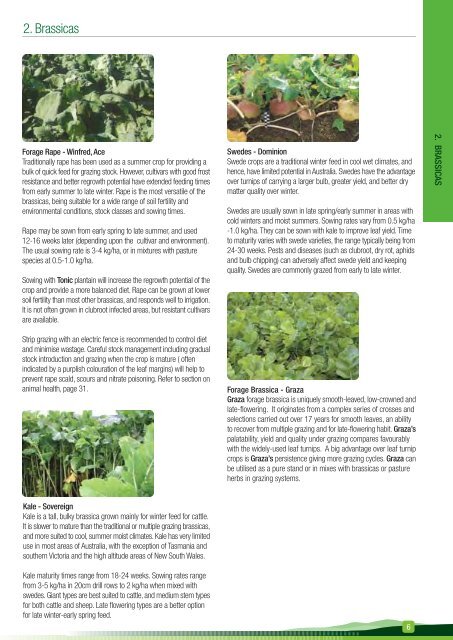Brassica Reference Manual - Agricom
Brassica Reference Manual - Agricom
Brassica Reference Manual - Agricom
You also want an ePaper? Increase the reach of your titles
YUMPU automatically turns print PDFs into web optimized ePapers that Google loves.
2. <strong>Brassica</strong>s<br />
Forage Rape - Winfred, Ace<br />
Traditionally rape has been used as a summer crop for providing a<br />
bulk of quick feed for grazing stock. However, cultivars with good frost<br />
resistance and better regrowth potential have extended feeding times<br />
from early summer to late winter. Rape is the most versatile of the<br />
brassicas, being suitable for a wide range of soil fertility and<br />
environmental conditions, stock classes and sowing times.<br />
Rape may be sown from early spring to late summer, and used<br />
12-16 weeks later (depending upon the cultivar and environment).<br />
The usual sowing rate is 3-4 kg/ha, or in mixtures with pasture<br />
species at 0.5-1.0 kg/ha.<br />
Sowing with Tonic plantain will increase the regrowth potential of the<br />
crop and provide a more balanced diet. Rape can be grown at lower<br />
soil fertility than most other brassicas, and responds well to irrigation.<br />
It is not often grown in clubroot infected areas, but resistant cultivars<br />
are available.<br />
Strip grazing with an electric fence is recommended to control diet<br />
and minimise wastage. Careful stock management including gradual<br />
stock introduction and grazing when the crop is mature ( often<br />
indicated by a purplish colouration of the leaf margins) will help to<br />
prevent rape scald, scours and nitrate poisoning. Refer to section on<br />
animal health, page 31.<br />
Kale - Sovereign<br />
Kale is a tall, bulky brassica grown mainly for winter feed for cattle.<br />
It is slower to mature than the traditional or multiple grazing brassicas,<br />
and more suited to cool, summer moist climates. Kale has very limited<br />
use in most areas of Australia, with the exception of Tasmania and<br />
southern Victoria and the high altitude areas of New South Wales.<br />
Kale maturity times range from 18-24 weeks. Sowing rates range<br />
from 3-5 kg/ha in 20cm drill rows to 2 kg/ha when mixed with<br />
swedes. Giant types are best suited to cattle, and medium stem types<br />
for both cattle and sheep. Late flowering types are a better option<br />
for late winter-early spring feed.<br />
Swedes - Dominion<br />
Swede crops are a traditional winter feed in cool wet climates, and<br />
hence, have limited potential in Australia. Swedes have the advantage<br />
over turnips of carrying a larger bulb, greater yield, and better dry<br />
matter quality over winter.<br />
Swedes are usually sown in late spring/early summer in areas with<br />
cold winters and moist summers. Sowing rates vary from 0.5 kg/ha<br />
-1.0 kg/ha. They can be sown with kale to improve leaf yield. Time<br />
to maturity varies with swede varieties, the range typically being from<br />
24-30 weeks. Pests and diseases (such as clubroot, dry rot, aphids<br />
and bulb chipping) can adversely affect swede yield and keeping<br />
quality. Swedes are commonly grazed from early to late winter.<br />
Forage <strong>Brassica</strong> - Graza<br />
Graza forage brassica is uniquely smooth-leaved, low-crowned and<br />
late-flowering. It originates from a complex series of crosses and<br />
selections carried out over 17 years for smooth leaves, an ability<br />
to recover from multiple grazing and for late-flowering habit. Graza’s<br />
palatability, yield and quality under grazing compares favourably<br />
with the widely-used leaf turnips. A big advantage over leaf turnip<br />
crops is Graza’s persistence giving more grazing cycles. Graza can<br />
be utilised as a pure stand or in mixes with brassicas or pasture<br />
herbs in grazing systems.<br />
6<br />
2. BRASSICAS


